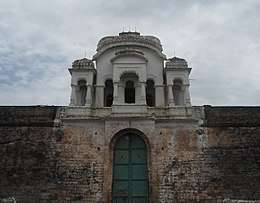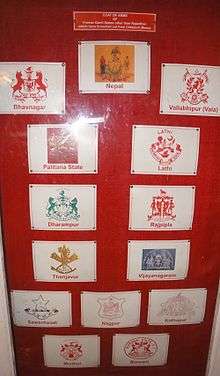Pusapati
Poosapati / Pusapati was the ruling clan of the Kalinga Vizianagaram (founded in late 16th century AD). They were Kshatriyas of the Pericchedi ruling clan of Andhra.
History


The Pericchedi kings were ancestors of the Pusapati royal family who built Bezawada (Modern Vijayawada) off the river Krishna by 626 AD and another capital in Kollipaka establishing themselves for nine centuries there.[1] They were staunch patrons of Hindu Dharma in contrast to the Chalukyas, who initially were patrons of Jainism.[2] The family name was changed to Pusapati after moving to the coastal region. They founded the city of Vizianagaram, and named it after Pusapati Vijay Rama Raju, spelled with a Z to differentiate it from the Vijayanagar Dynasty in Hampi. They obtained the title of Gajapathi in the 16th century, after vanquishing the Gajapatis (of Orissa) in the battle of Nandapur (modern Jeypore), in the Northern Circars, and have used since then. In 1484 Pusapati Rachi Raju wrote Vasistha Gotra Kshatriya Sisa Malika.
The Rajas allied themselves with the Gajapathi Emperor of Orissa against the Vijayanagar Empire initially but after being conquered by Krishnadevaraya they became their feudal allies. They, along with the other allies of Vijayanagar were conquered by Sultan Quli, the founder of the Qutub Shahi dynasty of Golkonda but by 1652 the 5th king of the subsequent Pusapati line was made Subahdar of the Northern Circars and they re-established themselves in the Vizagapatnam country. Emperor Aurangzeb has given them a two-edged sword 'pattaa kaththi' (Telugu:పట్టాకత్తి) (Zulfiqar), which is still used in the coat-of-arms of the family. By 1713 they erected the fort at Vizianagaram where they have since resided. In 1827 Maharajah Vijay Rama Gajapati Raju III. had several honors conferred on him by the British Government. Lord Northbrook obtained for him the title of His Highness, and had his name enrolled among those of chiefs entitled to return visits from the Viceroy with a 13 gun salute.
Poosapati / Pusapati rulers

- Up to 1509 A.D. The Pusapatis were ruling in Vijayawada, They were referred to as descendants of Madhava Varma of Bezawada, as that is what Vijayawada was called at the time.
- Pusapati Rachi Raju (1515 A.D.)He was an ally of the Gajapathi King Rudra Deva, they were both defeated by the Vijayanagar Emperor Krishna Deva Raya. After his defeat, Krishna Deva Raya reinstated him and He and Rachi Raju married the daughters of Rudra Deva.[3]
- Pusapati Amala Raju (Founder)
- Pusapati Tama Bhupaludu (1620–1670)
- Pusapati Sita Rama Chandra Raju (ruled 1685–1697) In 1687 A.D. when Mughal emperor Aurangzeb conquered Golkonda, Sita Rama Chandra Raju obtained the Zulfikar (Two edged sword) that figures on the Pusapati flag from the emperor as a token of appreciation for having assisted him in his campaign.[4]
- Pusapati Vijayarama Gajapati Raju I (ruled 1710 – died 1757) (Founder of Vizianagaram, moved the capital from Potnur) Killed in the Battle of Bobbili
- Pasupati Ananda Raju (died 1760) Captured Visakhapatnam and Rajamundry[5]
- Pusapati Vijayarama Gajapati Raju II (1760–1794) Died in the battle of Padmanabham against the British. Vijaya Rama Raju's brother Sita Rama Raju attacked Parlakamedi along with their Maratha allies and conquered it.
- Pusapati Narayana Babu Raju (1794–1845)
- Pusapati Vijaya Rama Gajapati Raju (1845–1879)
- Pusapati Ananda Gajapati Raju (1850–1897)
- Pusapati Vijaya Rama Gajapati Raju (1897–1922)
- Pusapati Alaka Narayana Gajapati Raju (1922–1937)
- Pusapati Vijaya Rama Gajapati Raju (1924–1995)
- Pusapati Ananda Gajapati Raju (1950-2016)
- Pusapati Ashok Gajapati Raju (1951-)
Notable members
- Poosapati S Kumaraswamy Raja - Former Chief Minister of Madras Presidency (Tamil Nadu) (1949–52) and Governor of Orissa (1954–56).[6][7]
- Sir Pusapati Vijayananda Gajapathi Raju also known as Maharajkumar of Vizianagram or Vizzy - Former Indian cricketer, Cricket administrator and Politician.
References
- ↑ A History of Telugu Literature p. 36
- ↑ Mediaeval Jainism: With Special Reference to the Vijayanagara Empire by Bhasker Anand Saletore
- ↑ Vizianagaram Zamindars
- ↑ Andhra Pradesh (India) (2000). Andhra Pradesh District Gazetteers: Vizianagram. Director of Print. and Stationery at the Government Secretariat Press; [copies can be from: Government Publication Bureau, Andhra Pradesh]. Retrieved 2014-11-19.
- ↑ Francis, W. (2002). Gazetteer of South India. Mittal Publications. p. 254. Retrieved 2014-11-19.
- ↑ Rajapalayam History Archived 2008-12-04 at the Wayback Machine.
- ↑ Virudhunagar Official Weblink